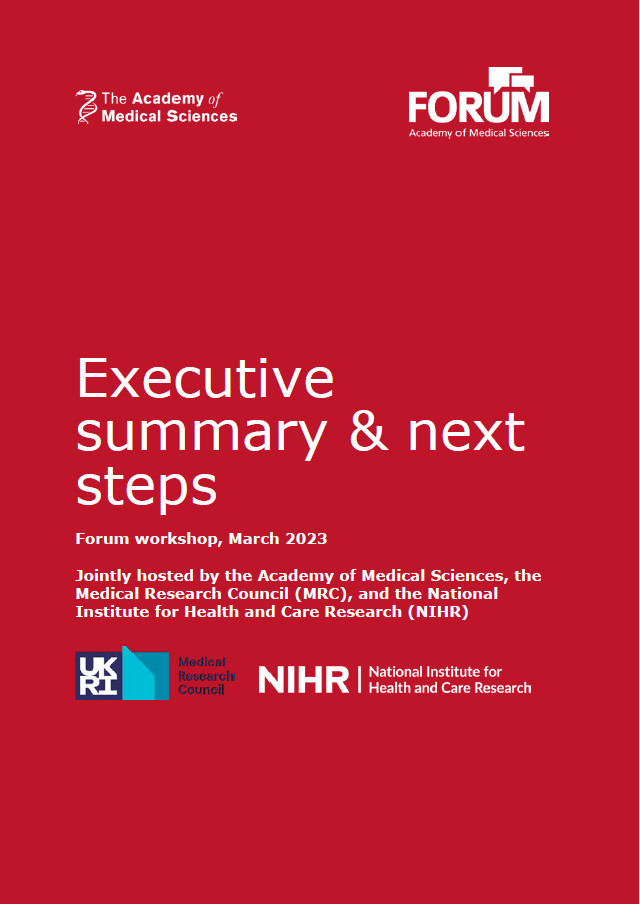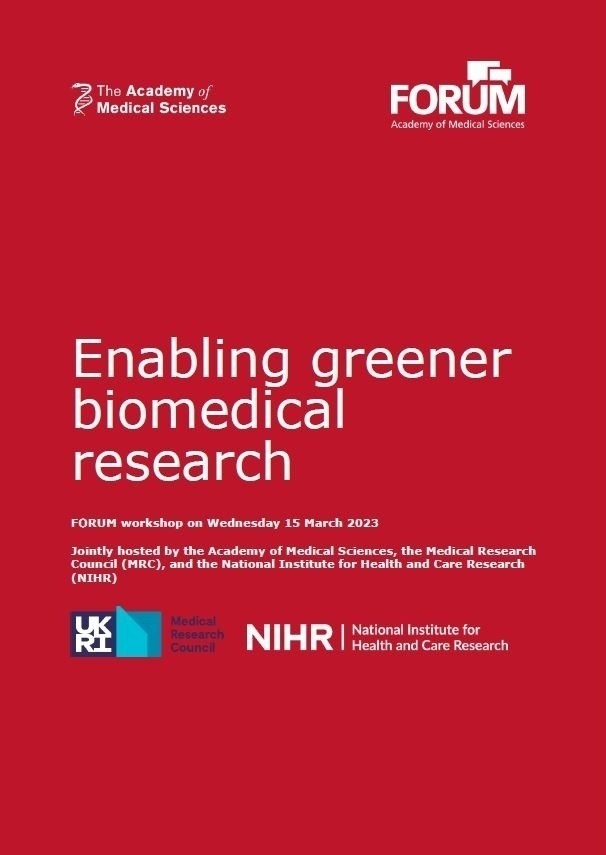The biomedical research sector, including wet lab and clinical research, has particular environmental impacts, with the need for single-use plastics, vast water consumption of laboratories, and the production of waste and use of reagents. What can be done to make biomedical research more environmentally sustainable, to save our planet as well as our health?
Addressing the climate crisis is of increasing urgency, and each sector must find ways to reduce their carbon emissions. Individuals and organisations are already pioneering greener approaches to research practice, delivering carbon savings, and in some cases cost savings as well. Action can and must be taken now to make research greener.
Our FORUM workshop, held in partnership with the Medical Research Council (MRC) and the National Institute of Health and Care Research (NIHR), brought together participants from different research contexts, including early-career and senior researchers, laboratory technicians and managers, sustainability experts from industry, academia, and healthcare, and funders and regulators. Participants discussed the barriers to greener research and proposed ways to tackle them.
Here are five of their key ideas to make health research greener:
1. Make environmental sustainability as integral to good research as health and safety.
Sustainability needs to become part of the culture of good research practice. To achieve this, changes are needed at an organisational level, including clearly defined standards such as those for health and safety, to ensure consistent best practice.
Sustainability standards could be modelled on initiatives such as My Green Lab and the LEAF (Laboratory Efficiency Assessment Framework) initiative. LEAF enables researchers and technical staff to benchmark the sustainability and efficiency of their laboratories across ten categories, and receive bronze, silver, or gold levels of certification depending on how many actions they take to save plastics, water and energy use. More than 2000 laboratories have signed up to LEAF, and studies show that it has helped save 2.9 tonnes of CO2 equivalent and an average of £3700 per laboratory per year.
2. Coordinate strategic commitments, investment, and action from senior stakeholders.
Currently, action is mostly driven by individual ‘champions’ taking on additional work outside of their role, which is fragmented and difficult to sustain against the competing demands of their full-time work, and with insufficient resources. As an urgent priority, there should be increased commitment from leaders to improve the environmental sustainability of research.
A better-resourced, coordinated ‘top-down’ approach will be necessary so that information, tools and resources can be shared, and evidence-based metrics and standards can be developed.
3. Build capacity within the workforce.
We need more people studying greener research practices to drive innovation and help fill a knowledge gap, so that products and processes can be compared and making green choices becomes easy. For example, there is currently a lack of evidence about the environmental impact of the whole-life cycle of products purchased for laboratories, including the carbon footprint of manufacturing, distribution, and disposal, as well as operational use.
Environmental sustainability should also be recognised as a specialism and included in job descriptions for technical staff, to remove the burden on individuals working with insufficient resources. This critical mass of experts studying and implementing greener research practice will need tools and training.
4. Focus more on green practice in clinical trials.
Environmental sustainability has yet to be prioritised in clinical research to the same extent as in laboratory research. The clinical research community face additional challenges, and they currently lack a central focal point or accreditation scheme such as LEAF for researchers wanting to look at environmental impact. While initial projects are underway to quantify the carbon footprint of clinical trials, regulators should examine how they might enable and encourage more sustainable practice. Additionally, new approaches such as remote monitoring, to reduce emissions from participant and investigator travel, could be explored.
5. Involve patients in making biomedical research green.
Patients and the public should be involved in the design of greener clinical research so that methods to reduce the carbon footprint of studies, such as asking them to assess their symptoms from home to avoid emissions from travel, are acceptable to trial participants. In addition, lessons should be learnt from the ways that public and patient involvement in research was embedded into good practice, through regulators’ and funders’ introduction of policies and standards.
Professor Frank Kelly FMedSci, Battcock Chair in Community Health and Policy at Imperial College London and co-chair of the ‘Enabling greener biomedical research’ report, said:
“There are clearly significant environmental impacts of research. Climate change is one of the greatest threats to human health, but we need biomedical research to continue improving health. While initiatives are currently underway to try to make research more green, many challenges remain, and this is particularly true in biomedical research. The solutions set out in this report suggest the steps needed to build a system that will enable greener research, and make it the default.”
As there has been limited progress in promoting environmentally sustainable clinical research, a panel discussion was held to better understand some of the challenges and solutions to greener clinical research. This panel discussion was part of the Royal Society’s ‘Sustainability in the research and innovation endeavour’ conference, on Wednesday 17 May 2023.
Panel members emphasised the need for collaboration across industry, academia, and sustainability experts, across borders and sectors, to push the agenda for greener clinical research. They called for tools and training so that the environmental impact of trials can be measured and reported by researchers, and taken into account by funders. There was also a resounding call to involve patients and the public in the development of greener trials.
Prof Susan Michie FMedSci, Professor of Health Psychology and Director of the Centre for Behaviour Change at University College London, and a participant on the panel, said:
“We have to think big to change research practice and make it more green. We have to think about systems, at the same time as thinking about the human behaviours that we need to change. People need knowledge and skills to change their behaviour, as well as the opportunity to change and the motivation. Remote monitoring for clinical trials may be a greener alternative, but it requires an interaction with technology. Not everyone has the capability to do this, and some may not have the motivation. So, we need to involve the community in our design of more sustainable research, to ensure we’re not excluding important sectors of the population in our studies.”
The ’Enabling greener biomedical research’ meeting was held on Wednesday 15 March 2023. It was convened as part of the Academy’s FORUM programme, which was established in 2003 to recognise the role of industry in medical research and to catalyse connections across industry, academia and the NHS.
If you would like information on the benefits of becoming a FORUM member, please contact [email protected].
The ’Enabling greener biomedical research’ report was covered in Research Professional.

